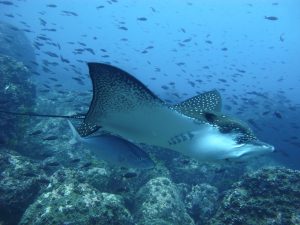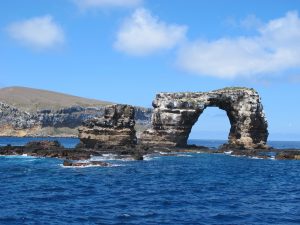Named in honour of famous English naturalist Charles Darwin, Darwin Island is the smallest in the Galapagos Archipelago. It was previously called Culpepper Island. Most of the island is underwater, and so the most important attraction is the Pacific Ocean.
Darwin Island is located northwest of the main Galápagos Island group and contains the remains of an extinct volcano. However, it is not open for land visits. The only way to visit the island and its marine life is to scuba dive, or on some cruise ships.
What to See

Darwin Island is home to some of the most diverse wildlife in the area. Tourists and divers can see great schools of fish, marine turtles, giant manta rays, eagle rays, tuna schools, Galapagos sharks, dolphins, whales, cold and warm water species and much more.
The waters are also home to Shark whales, hammerhead shark, barracuda sharks, hawksbill turtles, green turtles, and humpback whales. The island itself is the nesting ground for many types of birds, such as the great frigate. Also, don’t miss Darwin’s Arch, a natural rock arch off the southeast coast.
What is the best time to visit for you?

- January – June: This is the wet season when the rains can be heavy; the best time to see egg hatching and tortoise mating
- July – December: This is the dry season; peak months for seeing whale sharks
While planning your trip to Ecuador, or the Darwin Island, remember that there are numerous hotels and resorts available in and around the Galapagos islands, but you cannot actually stay on Darwin Island.
Do’s and Dont’s

DON’T
Do not bring food from to the island.
Do not try to take away stones or corals, without permission
Always maintain distance from the from the animals
Do not feed animals
Do not use flash photography
Do not smoke or set fires
DO
Carry water bottles
Wear lightweight jackets
Bargain the prices
Use hats, glass, and sunscreens to tolerate the weather
Wear shoes before stepping into water and sand
Camp in the designated area
Read more: The other Islands of the Galapagos